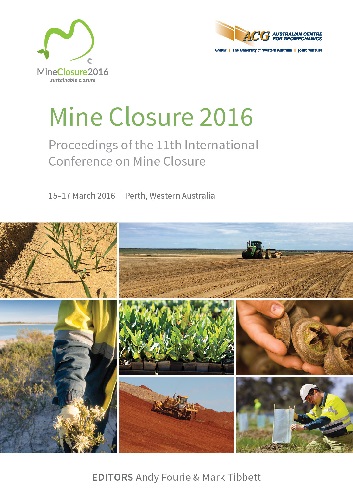Mine waste characterisation — complexities with assessing the physical properties of rock

|
Authors: Mackenzie, S; de Kever, N; Smedley, E; Gregory, S |
DOI https://doi.org/10.36487/ACG_rep/1608_50_Mackenzie
Cite As:
Mackenzie, S, de Kever, N, Smedley, E & Gregory, S 2016, 'Mine waste characterisation — complexities with assessing the physical properties of rock', in AB Fourie & M Tibbett (eds), Mine Closure 2016: Proceedings of the 11th International Conference on Mine Closure, Australian Centre for Geomechanics, Perth, pp. 677-690, https://doi.org/10.36487/ACG_rep/1608_50_Mackenzie
Abstract:
The aim of mine waste characterisation is to assess the geochemical and physical properties of rock in order to identify deleterious or beneficial materials. Mine waste geochemistry is generally well understood and there are accepted procedures to assess the geochemical properties of rock. Predicting the physical properties of mine waste is more difficult and practitioners are achieving mixed results with varied methods. Routine soil science techniques are commonly applied to assess the physical properties of rock. Such techniques measure the resultant properties of rock, without considering the geological factors that control those properties. Such testwork results can be unreliable in predicting erosion potential of rock. Furthermore, practitioners may fail to develop a working appreciation of deposit scale geology prior to sample collection and testwork. In many cases such limitations result in incorrect predictions relating to the physical properties of rock. There are five geological factors that control the physical properties of rock: petrology/lithology, alteration, mineralogy, weathering and structural deformation. The interplay between these factors in determining the as-dumped erosion stability of rock on a mining landform can be complex. This paper considers the geological factors that control the physical properties of rock, the effectiveness of current assessment methods and opportunities to advance current practice. Field data is used to support observations where applicable.
Keywords: Mine waste characterisation, waste rock, erosion potential, physical properties
References:
Clarke, KR & Gorley, RN 2006, Primer V6: User Manual/Tutorial, PRIMER-E. Ltd, Plymouth.
Davis, GH & Reynolds, SJ 1996, Structural geology of rocks and regions, Second edition, John Wiley & Sons Inc.
McGeary, D, Carlson, DH & Plummer, CC 2006, Physical Geology, Seventh Edition, McGraw-Hill Higher Education.
McQueen, KG & Scott, KM 2009, ‘Rock weathering and structure of the regolith’, in KM Scott & CF Pain (eds), Regolith Science, CSIRO Publishing, Australia, pp. 105–126.
Scott, KM & Pain, CF 2009, Regolith science, CSIRO Publishing.
Smedley, E, Mackenzie, S, Astill, W, Campbell, G & Haymont, R 2014, ‘Cost effective integrated assessment of mine waste and practical management solutions’, paper presented at the Goldfields Environmental Management Group conference in Kalgoorlie WA, May 2014.
Thompson, AJB & Thompson, JFH (eds) 1996, Atlas of alteration – a field and petrographic guide to hydrothermal alteration minerals, Geological Association of Canada, Mineral Deposits Division.
Winter, JD 2010, An introduction to igneous and metamorphic petrology, Second edition, Pearson Education Inc.
© Copyright 2025, Australian Centre for Geomechanics (ACG), The University of Western Australia. All rights reserved.
View copyright/legal information
Please direct any queries or error reports to repository-acg@uwa.edu.au
View copyright/legal information
Please direct any queries or error reports to repository-acg@uwa.edu.au